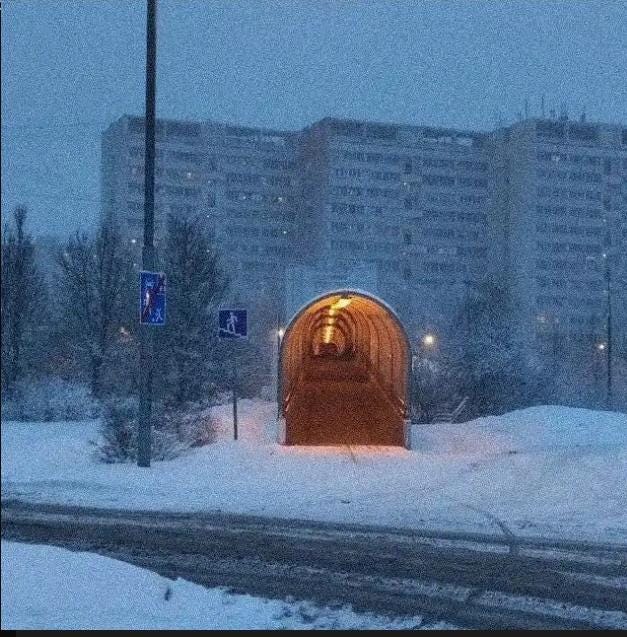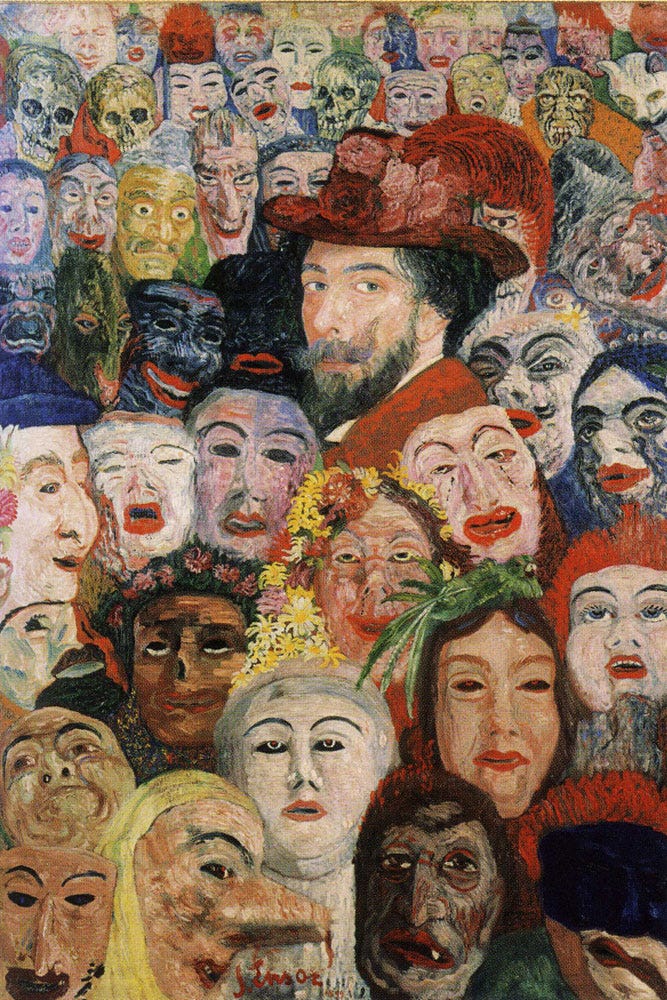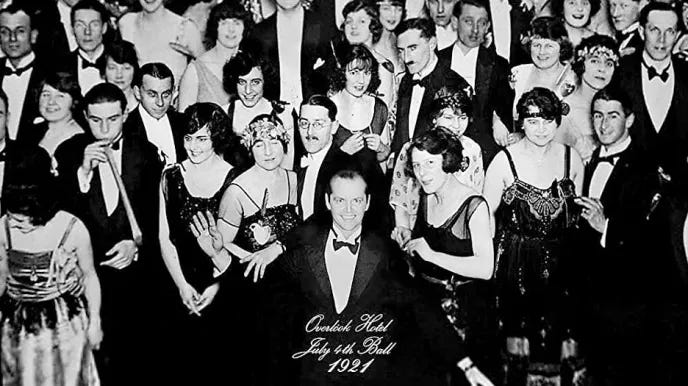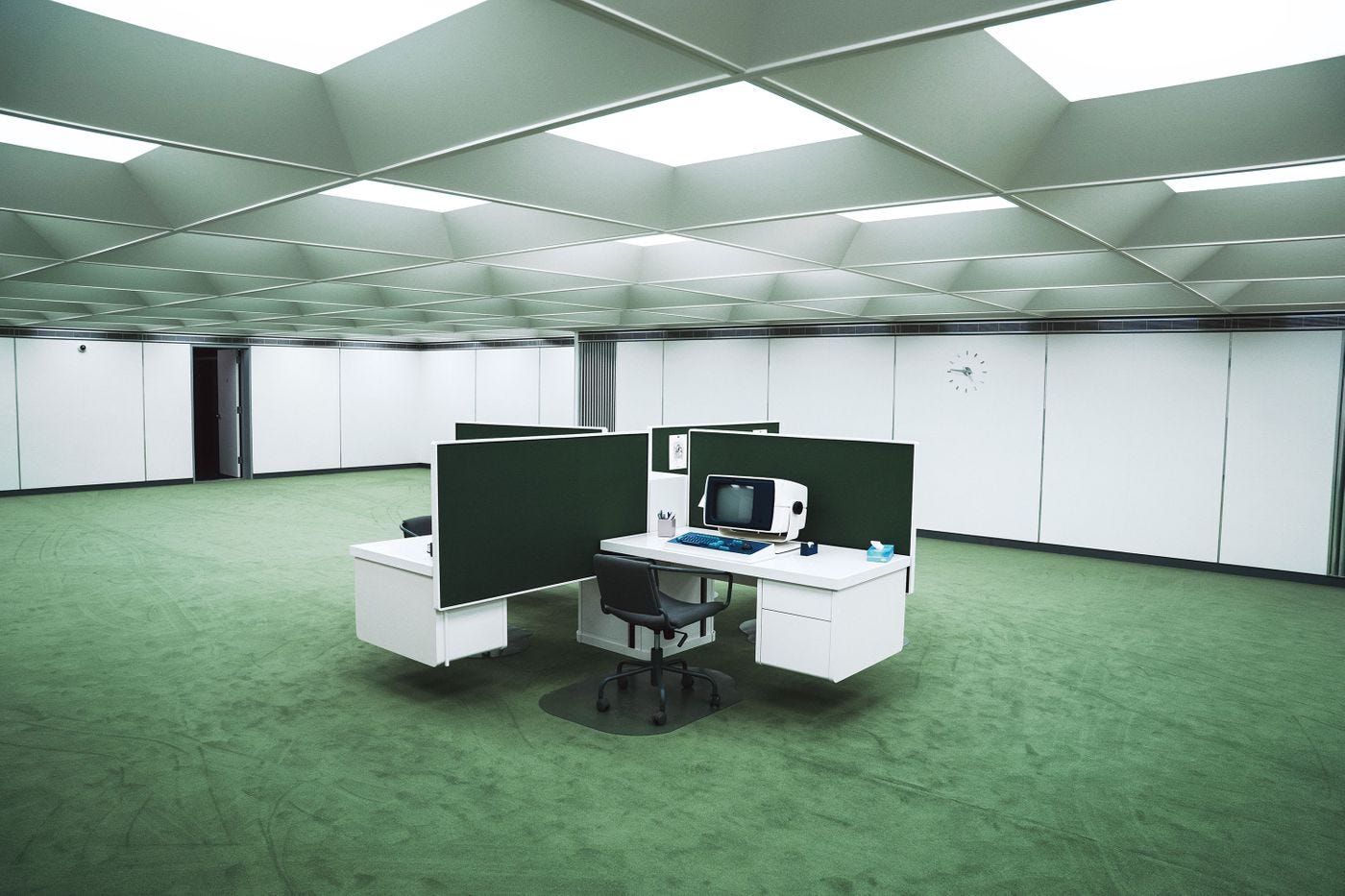The Definitive Guide to Liminal Media
How to Cope When the World is Stuck on a Loading Screen
Hi, I’m an existential imbecile named Max Murphy. Here on The Murphy Memos we explore the absurdity of existence.
Consider subscribing if you’re into that kinda thing.
We’re living in a liminal age. Humanity is in a dark tunnel, a thoroughway where no one is quite sure what the other side holds in its imaginary, undefined hands. In Rites of Passage, Arnold van Gennep described 3 phases:
Pre-liminal: known structures of life
Liminal: ambiguous transitional period
Post-liminal: new and transformed normal
Today, society is collapsing. Like Rome, there’s no one distinct “fall” but millions of micro manifestations of the polycrisis which keep bubbling up in cartoonishly, heartbreaking ways. In a recent post,
described the US as, “a wealthy country where everything visible seems to be slowly breaking while everything invisible keeps getting richer.”Look outside your window right now, and you’ll likely see signs of decay, just as one might see in an abandoned house. As if civilization itself has been abandoned. This too shall rot. It can be difficult coming to terms with, but friend, this is the world we live in. A gradual societal transformation, a seemingly infinite tunnel of darkness, what I like to call the liminal age.
Liminal media—whether we consciously realize it or not—helps cope with this overwhelming sense of ambiguity.
What I like most about liminality is that, while it captures this collective foreboding anxiety, it also contains a glimmer of hope. This isn’t forever. There will be a new normal. But until we can greet that new normal with open arms, there’s only a very long present moment suspended in perpetuity.
One Tumblr user wrote, “i really enjoy just existing in hotels. the long identical hallways. the soulless abstract art. the weird noises the air conditioner makes. strange city lights in the window. six stories off the ground. strangers chatting in the hall. nothing in the dresser. no past, but an infinite present.”
Humanity is a teenager wondering through dimly lit hotel hallways in the middle of the night, unsure how we got here, what we’re doing, or where we’re going.
After a lifetime obsession with the liminal, the definitive guide to liminal media was screaming to be born. The list is organized into four categories. I won’t be explaining those categories because that makes this more liminal, so here we go:
🏛️ Architectural Liminality
Non-Places: Introduction to an Anthropology of Supermodernity by Marc Augé (1992 Non-Fiction book): Defines the transient, anonymous spaces of supermodernity—airports, motorways, supermarkets—where human beings remain anonymous and never find a true “place.”
The Shining by Stephen King (1977 novel, 1980 Film): The Overlook Hotel—a transient place for short stays—becomes a permanent, haunted prison, with uncanny architecture that traps the family in a cycle of past violence.
House of Leaves by Mark Z. Danielewski (2000 Novel): The house on Ash Tree Lane is literally bigger on the inside than the outside, containing an ever-shifting, dark labyrinth that physically manifests the psychological liminality of its inhabitants.
The Stanley Parable (2013 Game): You navigate a sterile, looping office building where the narrator’s voice is your only guide, turning the mundane architecture into a meta-commentary on choice, freedom, and the illusion of control.
Superliminal (2019 Game): A puzzle game that uses perspective to make doors and hallways lead to impossible places.
NaissancE (2014 Game): A free indie walking simulator that immerses you in a massive, abandoned, and impossibly large cyclopean structure, creating a pure, wordless atmosphere of exploration and awe.
The Location of Culture by Homi K. Bhabha (1994 non-fiction book): Introduces concepts like the “third space” and hybridity, which are deeply liminal in nature, describing the creative and disruptive power of cultural interstices and migrant identities.
Control (2019 Game): The “Oldest House” is a brutalist skyscraper that is a shifting, extradimensional space, where offices reconfigure themselves and hallways lead to other dimensions.
Stalker (1979 Film): The “Zone” is a mysterious, forbidden landscape where the very laws of physics seem suspended, creating a physical and spiritual liminal space that reflects the inner desires of those who enter.
Out of Bounds by The Cursed Judge (2022 video essay): A fascinatingly original exploration of that weird feeling you get when you glitch out out of the map in video games.
Liminal Spaces by Solar Sands (2020 video essay): the foundational video on liminal spaces.
Parasite (2019 Film): The Park family’s minimalist, sunken living room home and the stark, hidden world beneath it architecturally represent the rigid, invisible class boundaries of modern society.
Piranesi by Susanna Clarke (2020 Novel): A boundless, oceanic House of endless marble halls, whose tides and statues map the architecture of a forgotten cosmology and the mind of the man who wanders it.
Playtime (1967 Film): Jacques Tati’s vision of a modernist Paris made entirely of glass, steel, and sterile transit spaces turns the entire city into a comic and dehumanizing non-place.
The Backrooms (2019 Internet Lore): The crowdsourced archetype of architectural liminality: an endless expanse of yellowed wallpaper and fluorescent hum that you “noclip” into when you fall out of reality.
Contrapoints: Liminal Spaces (2023 Video Essay): A deep dive into the aesthetic and philosophy of liminal spaces, exploring why empty pools and hallways evoke such a potent mix of nostalgia and dread.
The Haunting of Hill House by Shirley Jackson (1959 novel, 2018 TV Series): The titular mansion is a classic gothic liminal space, a house that is itself a ghost.
Mirror’s Edge (2008 Game) and Mirror’s Edge: Catalyst (2016): The city as a sterile, oppressively clean circuitboard; a landscape of gleaming rooftops and pristine ducts that exists only for the first-person, flow-state of parkour movement as an act of rebellion.
In Praise of Shadows by Jun’ichirō Tanizaki (1933 Essay): A meditation on how traditional Japanese architecture uses darkness and ambiguity to create spaces that feel suspended between the material and spiritual worlds.
The Poetics of Space by Gaston Bachelard (1958 Non-Fiction book): The philosophical foundation for how we experience intimate spaces like attics and drawers, which are liminal in their own way, as half-real domains of memory and imagination.
Koyaanisqatsi (1982 Film): Through time-lapse photography, it turns cities, freeways, and housing projects into flowing, inhuman architectural landscapes, rendering the man-made world alien and transitional.
Myst (1993 Game): A series of abandoned, beautiful, and puzzle-filled “Ages” that are the definition of liminal worlds waiting to be traversed, each one a self-contained, melancholic reality.
Grey Gardens (1975 Documentary): The decaying estate becomes a liminal space between past grandeur and present ruin, physically trapping its two inhabitants in a nostalgic memory of their former lives.
The City & The City (2009 Novel): Two cities occupy the same physical space, and citizens must “unsee” the other, creating a masterclass in socially-constructed architectural liminality.
Videodrome (1983 Film): The television screen becomes a liminal architectural portal, a “new flesh” that dissolves the boundary between the body and the broadcast space, making reality itself a channel to be changed.
The Night House (2020 Film): A widow discovers her husband was secretly building a mirrored, negative-image of their house, a literal architectural doppelgänger that serves as a liminal space for the dead.
🧠 Psychological Liminality
The Metamorphosis by Franz Kafka (1915 Novella): Gregor Samsa’s transformation into a vermin physically manifests the psychological limbo of modern human existence.
Wedding Preparations in the Country by Franz Kafka (1907 Short Story): Kafka’s protagonist Raban fantasizes about sending his “clothed body” to the country while his true, “beetle” self stays in bed, exploring the split between our social and inner selves.
Severance (2022 TV Show): The surgical procedure literally splits consciousness into two separate selves, creating the ultimate psychological horror of being trapped between two incompatible identities and memories.
I’m Thinking of Ending Things (2020 Film): A woman’s reality dissolves during a road trip to meet her boyfriend’s parents, blurring the lines between memory, fantasy, and identity in a single, unresolved psychological moment.
American Psycho (1991 Novel): Patrick Bateman is a man who is only a mask, a collection of business cards and restaurant reservations, with no core self underneath, representing the ultimate psychological void of modernity.
The Uncanny by Sigmund Freud (1919 Essay): Freud defines the “unheimlich” as the feeling when something familiar becomes strangely unfamiliar, which is the core emotional response to psychological liminality and the doppelgänger.
Betwixt and Between: The Liminal Period in Rites de Passage by Victor Turner (1967 essay): A crucial essay that elaborates on the symbolic and experiential qualities of the liminal state, where individuals are stripped of their old identity but have not yet acquired a new one.
Horror in Impossible Places by Super Eyepatch Wolf (2022 video essay): an extremely entertaining deep dive on the spoopy feeling behind liminality.
Society of the Spectacle by Guy Debord (1967 Non-Fiction book): Argues that authentic social life has been replaced by its representation—the “Spectacle”—forcing us to live through a mask, alienating us from our true lived experience.
The Burnout Society by Byung-Chul Han (2010 Non-Fiction book): Posits that we have become a society of self-exploiters, where the individual is simultaneously the prisoner and the warden of their own mind, leading to exhaustive depression and anxiety.
Fight Club by Chuck Palahniuk (1996 novel, 1999 Film): don’t talk about fight club.
Perfect Blue (1997 Film): A pop idol’s sanity fractures as she is stalked by a fan and her own double, blurring the lines between her stage persona and her true self until neither she nor the audience can tell what is real.
Mulholland Drive (2001 Film): David Lynch’s masterpiece is the cinematic equivalent of a nervous breakdown, using a literal narrative split to represent a fractured psyche dissolving under the weight of Hollywood dreams and trauma.
Taxi Driver (1976 Film): Travis Bickle is the archetype of the psychologically liminal man, a lonely alien who exists in the space between his violent vigilante fantasies and the decaying reality of the city around him.
Persona (1966 Film): Ingmar Bergman’s seminal work where the identities of a nurse and her patient begin to merge and dissolve
Synecdoche, New York (2008 Film): A theater director’s life and art become so intertwined that he builds a life-sized replica of New York inside a warehouse, creating an infinite regression of actors playing himself in a labyrinth of the self.
The Double by Fyodor Dostoevsky (1846 Novella): A meek bureaucrat is psychologically tormented by the sudden appearance of his exact double—a confident, charismatic man who systematically takes over his life in this foundational doppelgänger tale.
Annihilation (2018 Film): The “Shimmer” refracts the DNA and psyche of everything inside it, causing the explorers’ memories and identities to become unstable as they are remade into something alien and new.
The Stranger by Albert Camus (1942 Novel): Meursault exists in a state of psychological limbo, detached from the emotional and moral expectations of society, which culminates in a violent act he cannot explain or rationalize. If Mersault wasn’t so hard to spell, it would’ve been my pen name (Mersault Murphy ftw).
Black Swan (2010 Film): A dancer’s pursuit of perfection for the dual role of the Swan Queen causes her identity to dissolve into that of her role, creating a terrifying liminality between self and character.
The Yellow Wallpaper by Charlotte Perkins Gilman (1892 Short Story): A seminal feminist text about a woman’s descent into psychosis, trapped in the liminal space between prescribed “rest” and madness by the oppressive “care” of her husband.
Under the Skin (2013 Film): An alien being inhabits a human body, experiencing the world from a profoundly liminal perspective between observer and participant, predator and prey, human and Other.
The Echo Maker by Richard Powers (2006 Novel): A man develops Capgras syndrome after an accident, believing his sister is an imposter, trapping their relationship in a nightmarish liminal state of unrecognized love and suspicion.
Session 9 (2001 Film): The decaying Danvers State Mental Hospital acts as a catalyst, blurring the lines between the fractured psyches of an asbestos cleanup crew and the building’s own haunted, violent past.
The Man Who Mistook His Wife for a Hat by Oliver Sacks (1985 Non-Fiction book): Sacks’ clinical tales of neurological disorders reveal how fragile our sense of a continuous, unified self really is, existing on a precipice of dissolution.
Possessor (2020 Film): Assassins use brain-implant technology to inhabit other people’s bodies, creating a violent and disorienting liminality of identity where the killer risks losing themselves inside their host.
The Master (2012 Film): Explores the psychological liminality of a drifter searching for identity after WWII, and the charismatic cult leader who offers a path that may be just another form of spiritual captivity.
⏳ Temporal Liminality
Ghosts of My Life (2014 Non-Fiction book): Mark Fisher’s foundational text on “hauntology” argues that our culture is haunted by the “lost future” of the 20th century, leaving us stuck in a repeating, nostalgic present.
Specters of Marx by Jacques Derrida (1993 non-fiction book): Derrida’s work that popularized ‘hauntology,’ exploring how the legacy of Marxism haunts the post-Cold War world, arguing we have an ethical duty to the ‘specters’ of the past and the future-to-come.
Liquid Modernity by Zygmunt Bauman (2000 Non-Fiction book): Bauman’s theory that all solid structures—relationships, careers, identities—have melted into a perpetual, uncertain state of flux, making the present a continuous transition with no destination.
Spirited Away (2001 Film): The bathhouse for the gods is a liminal space outside of normal time, where Chihiro is trapped between her past life and an uncertain future in a world that operates on forgotten, folkloric time.
Neon Genesis Evangelion (1995 Anime Series): Set in a “post-Second Impact” world—a future that was supposed to be utopian but is instead a damaged, stagnant hellscape, obsessed with the failures of the past.
Twin Peaks: The Return (2017 TV Series): A massive, 18-hour meditation on corrupted time, where characters are trapped in phantom zones, glass boxes, and alternate dimensions, and the past violently erupts into the present.
Station Eleven by Emily St. John Mandel (2014 Novel, 2021 TV Series): Set in the decades after a flu pandemic collapses civilization, it follows a traveling theatre troupe navigating a world suspended between the lost past and a fragile future, where art and memory become the liminal spaces connecting humanity.
The Garden of Forking Paths (1941 Short Story): Jorge Luis Borges presents a conception of time not as a line, but as a constantly branching, infinite labyrinth where all possibilities coexist simultaneously.
Celebrations of Death: The Anthropology of Mortuary Ritual by Peter Metcalf & Richard Huntington (1979): A key application of Van Gennep and Turner to the ultimate liminal rite, analyzing how death rituals manage the social and spiritual transition of the deceased and the community.
Primer (2004 Film): This low-budget sci-fi presents the most realistic and horrifying depiction of time travel, where characters become trapped in a web of their own past and future selves, their timelines dissolving into an incomprehensible mess.
The Southern Reach Trilogy by Jeff VanderMeer (2014 Book Series): Area X is a process that is rewriting time itself, creating a landscape where the past is being consumed by a terrifyingly alien future.
Russian Ark (2002 Film): A narrator’s ghost drifts through St. Petersburg’s Hermitage Museum in a single, unbroken 96-minute take, gliding through three centuries of Russian history in a dreamlike, liminal space where all of time coexists simultaneously.
The Great Derangement by Amitav Ghosh (2016 Non-Fiction book): Ghosh argues that our inability to grapple with climate change is a failure of imagination, rooted in a culture stuck in a short-term, progress-obsessed temporal model.
Last Year at Marienbad (1961 Film): A film that exists entirely in a speculative, recursive past, where memory, fantasy, and persuasion are indistinguishable, creating a pure, elegant temporal limbo.
The Peripheral by William Gibson (2014 Novel): Explores “stubs,” alternate timelines created by meddling from the future, making the present a malleable and liminal concept that can be edited and controlled by outside forces.
Arrival (2016 Film): Learning an alien language that perceives time non-linearly forces the protagonist to experience her life—including its greatest joy and tragedy—in a completely non-chronological, liminal way.
The Leftovers (2014 TV Series): After 2% of the world’s population vanishes, the survivors are left in a state of collective psychological limbo, grappling with meaning, faith, and identity in a world that no longer makes sense.
The Weird and the Eerie by Mark Fisher (2016 Non-Fiction book): Fisher’s concepts of the “weird” and “eerie” are deeply tied to temporal disjuncture—the presence of something that shouldn’t be there, or the failure of something that should.
La Jetée (1962 Film): A masterpiece composed almost entirely of still images, about a man trapped in time, sent to the past and future, and obsessed with a memory from his childhood that holds the key to his fate.
Dark (2017 TV Series): A German town trapped in a 33-year time loop, where the past, present, and future are inextricably and tragically linked in a complex web of cause and effect that feels like a temporal prison.
The Factory of Facts (1998 Memoir): Luc Sante explores the liminal space of being an immigrant between two countries and two timelines—the “old world” of the past and the “new world” of the present.
12 Monkeys (1995 Film): A time traveler from a post-apocalyptic future becomes mentally unmoored, trapped in a past he is sent to observe but cannot change, in an asylum that is itself a temporal limbo.
📜 Sociological Liminality
The Trial by Franz Kafka (1925 Novel): Josef K. is arrested for an unspecified crime by a remote, inaccessible authority, placing him in a perpetual state of bureaucratic limbo that is the archetype of systemic, Kafkaesque liminality.
Bartleby, the Scrivener by Herman Melville (1853 Short Story): Bartleby’s passive resistance with the phrase “I would prefer not to” places him in a liminal space within the office, refusing to integrate into the system of labor while still physically occupying it.
Bullshit Jobs: A Theory by David Graeber (2018 Non-Fiction book): Graeber argues that a proliferation of pointless, demoralizing jobs is a political phenomenon that traps millions in a state of psychological and economic liminality, performing work they know is useless.
The Utopia of Rules by David Graeber (2015 Non-Fiction book): Graeber explores our society’s obsession with bureaucracy, arguing that it creates a world of “structural stupidity” where people are trapped following rules that have lost all connection to their original purpose.
White Collar: The American Middle Classes by C. Wright Mills (1951 Non-Fiction book): Mills’ classic study dissects how the modern office worker became a powerless cog in a vast bureaucratic machine, alienated from any sense of craft or purpose.
Sorry to Bother You (2018 Film): A telemarketer discovers that using his “white voice” is the key to success, forcing him into a liminal state of racial and class performance that leads to a surreal and horrifying revelation about the system.
Office Space (1999 Film): A satire of the soul-crushing absurdity of cubicle life, where workers are trapped in a liminal state of meaningless tasks, petty authority, and the desperate desire to escape.
The Rites of Passage by Arnold Van Gennep (1909): The ur-text that coined the term “liminality” from the Latin limen (threshold). It establishes the three-stage model (separation, margin, reaggregation) that defines transitions in social status and life.
The Ritual Process: Structure and Anti-Structure by Victory Turner (1969): The work that expanded Van Gennep’s concept into a broad social theory, defining the liminal stage as a potent space of anti-structure, community (communitas), and potential transformation.
The Uses and Meanings of Liminality by Bjørn Thomassen (2009): A key modern paper that reviews and synthesizes the anthropological tradition from Van Gennep and Turner, and proposes new applications for understanding contemporary political and social phenomena.
Liminal to Liminoid, in Play, Flow, and Ritual by Victor Turner (1974): Explores the crucial shift from obligatory, collective ritual liminality to the optional, individualistic “liminoid” experiences of leisure, art, and politics in industrial societies.
The Wolf of Wall Street (2013 Film): A hyper-real portrayal of a financial system that is itself a liminal space of pure speculation, where value is divorced from reality and morality is suspended in pursuit of endless wealth.
They Live (1988 Film): A drifter discovers special sunglasses that reveal the hidden sociological reality: a ruling class of aliens enforcing subliminal commands to “OBEY” and “CONSUME,” keeping the masses in a state of ideological limbo.
Maid (2021 TV Series): A devastatingly realistic portrayal of the “bureaucratic liminality” of poverty, where a single mother is trapped in the gaps of social safety nets, filling out endless forms to achieve basic security.
The Death of Ivan Ilyich by Leo Tolstoy (1886 Novella): A profound critique of bourgeois social conformity, where a dying judge realizes his entire life has been a performance, trapping him in a liminal state between his true self and the empty identity society demanded.
The Wretched of the Earth by Frantz Fanon (1961 Non-Fiction book): Fanon’s foundational text on the psychology of colonialism describes the liminal state of the colonized subject, caught betweenn a shattered native culture and an imposed foreign one.
The New Jim Crow by Michelle Alexander (2010 Non-Fiction book): Alexander details how the carceral system creates a permanent undercaste of citizens in a liminal state between freedom and a second-class status, stripped of basic rights.
Children of Men (2006 Film): A society in collapse after two decades of human infertility, where the loss of the future has created a global state of limbo, with refugees trapped in cages as the world gives up hope.
The Managed Heart by Arlie Hochschild (1983 Non-Fiction book): seminal text on “emotional labor” explores the liminal space where flight attendants and other service workers are forced to commodify and regulate their own feelings for a wage.
Nomadland (2020 Film): Follows modern-day nomads living in vans, existing in the sociological liminal spaces of America—rest stops, Amazon warehouses—as a precarious new class of disposable laborers.
The Souls of Black Folk by W.E.B. Du Bois (1903 Non-Fiction book): Du Bois introduces the concept of “double-consciousness,” a state of always looking at one’s self through the eyes of a racist society, which is a profound and enduring sociological liminality.
Squid Game (2021 TV Series): Contestants in dire financial straits are lured into a deadly competition, placing them in a liminal social structure with its own brutal rules, completely outside the norms and protections of regular society.
The Precariat: The New Dangerous Class by Guy Standing (2011 Non-Fiction book): Standing defines the new social class of the “precariat,” people with unstable lives and no occupational identity, living in a perpetual state of economic and social liminality.
Catch-22 by Joseph Heller (1961 Novel): The ultimate satire of bureaucratic logic, where the system creates impossible, liminal states for its subjects.
The Wailing (2016 Film): A Korean horror film where a village becomes a liminal space between the modern world and ancient shamanic forces, exposing the fragility of social order and the violent scapegoating that follows when that order breaks down.







That is a LOT of recommendations!
I came in here to plug my irregular and potentially-tenuously-appropriate morning show, "Liminal Mornings," where I play eclectic but generally chill music and make custom live visualizations.
https://djic.substack.com/p/liminal-mornings-start-november-3